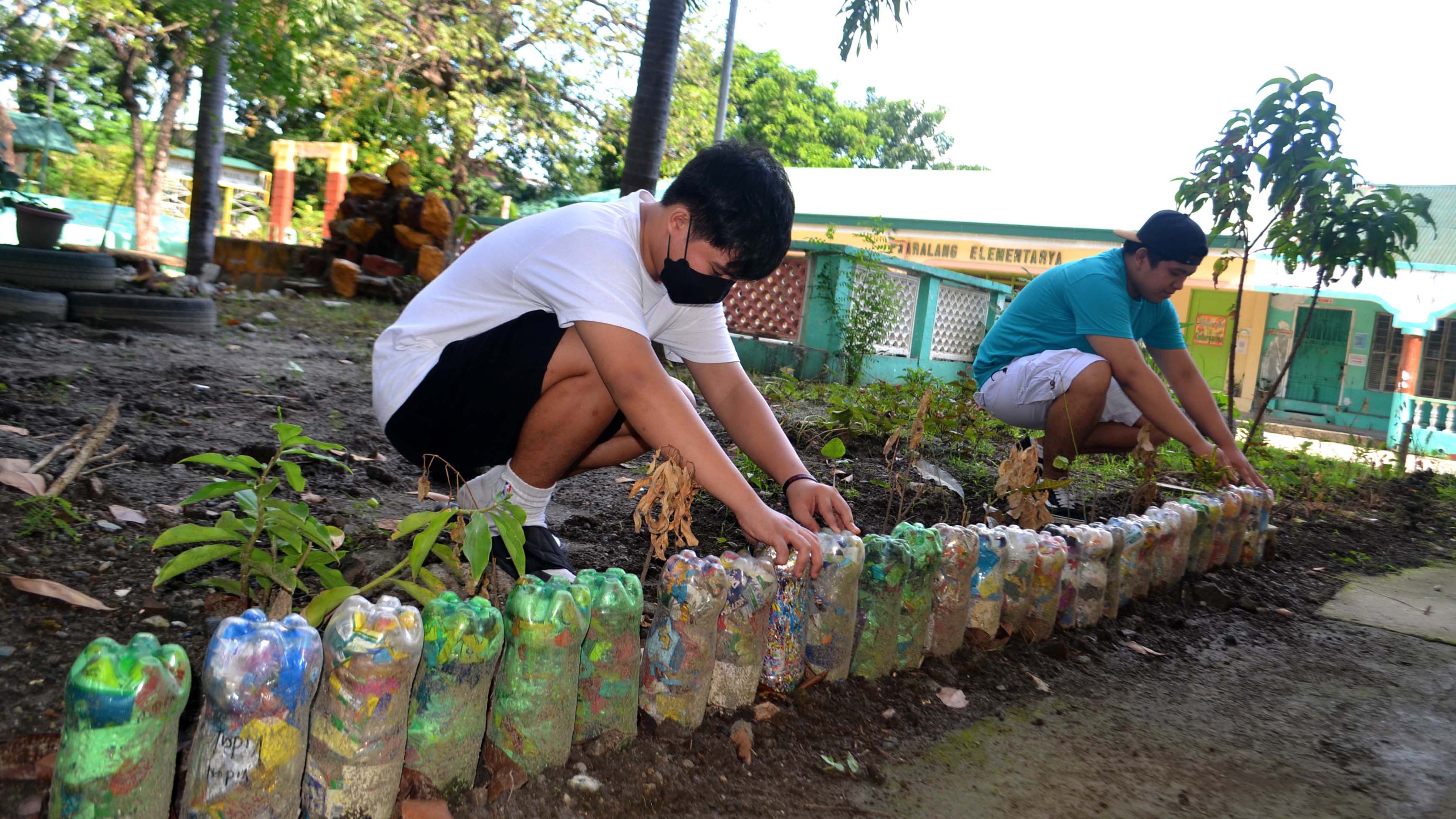A public school principal in Cavite is starting the students young teaching them how to gather and reuse the wrappers of junk foods and candies by cutting them into strips that can be stuffed inside recyclable bottles that can in turn be used for fences or as bottle bricks.
For six years now, Rhodora Sacramento, school principal from Cavite, has been training students to collect as many empty wrappers of candy or junk food to be cut into small strips and stuffed tightly inside the used plastic bottles. When full, the bottle bricks can be arranged as fences and pathway guides in the schools and homes.
This is her way of battling plastic waste since 2016, leading the War on Waste program to minimize garbage by convincing her students to make stuffed bottle bricks, giving them their own personal eco-bags and persuading them to throw used bottles and cans in convenient wireframe baskets. Collected bottles and cans are then sold to recyclers. Sales proceeds reached P2,500 in the first three months of the program, enough to fund one of her school organization’s Christmas parties.
Bottle bricks were traded to Robinsons Hypermart Bacoor for canvas eco-bags. The bottle bricks were used to build homes for the Yangil tribe in Zambales, while the eco-bags were distributed to Cavite students for their personal use. To further motivate students to maintain the school’s cleanliness, certificates and prizes were awarded to the cleanest rooms at the end of the school year.
“Our War on Waste has drastically reduced the garbage we generate. From around 20 garbage bags a week, we were down to five,” reveals Rhodora, who is currently principal of the Mabolo Elementary School in Bacoor.
Champions against plastic waste
The plucky principal is just one of many champions promoting viable ways to reduce plastic waste, preventing them from entering Philippine waterways. She says there are more solutions that can be developed and shared by other schools across the country.
According to the Environmental Management Bureau (EMB), Cavite generated an average of 1514 tons of waste daily in 2018, 22 percent or 333 tons of which could still be recycled. The Imus River traverses the highest waste-generating cities in Cavite – Bacoor, Dasmariñas and Imus – making it a conveyor belt for leaked plastic waste flowing out to Manila Bay.
“The Philippines has good solid waste management laws, like Republic Act 9003 or the Ecological Solid Waste Management Act,” explains Norlan Talay, a barangay secretary in the municipality of Silang. “The problem is effective implementation because there are too many residents and too few enforcers. Aside from ramping up enforcement efforts, we need residents to be more cooperative in managing waste. We should do all we can to take care of the world our past generations left us.”
Project ASEANO
Funded by the Government of Norway, Project ASEANO is led by the Norwegian Institute for Water Research (NIVA) and the Center for Southeast Asian Studies (CSEAS) Indonesia in close collaboration with the PEMSEA Resource Facility and ASEAN Secretariat under the purview of the endorsing ASEAN sectoral body, the ASEAN Working Group on Coastal and Marine Environment (AWGCME).
Project ASEANO promotes the development of sound and sustainable measures to reduce the impacts of plastic pollution and their implications on socioeconomic development and the environment. The project focuses on the local level, with Cavite’s Imus River as one of two project sites in Southeast Asia.
The results of the project will be synthesized into knowledge products (LGU toolkit and best practices policy handbook, monitoring tools and technologies for plastics management and so forth) that can be used as a reference by local governments across the ASEAN region with similar priority management concerns.
Residents can reduce their garbage
“Residents can do a lot to minimize the trash they generate. On the household level, they should start with proper segregation, separating waste from items that can still be reused, salvaged or recycled,” says Dr. Ed Lineses of De La Salle University Dasmariñas, who led a part of Project ASEANO’s series of studies
. “Households can also choose not to use plastic. There are many things we can buy without using plastic packaging. Policymakers should also be more creative in finding ways to incentivize the refusal of plastics by collaborating with sellers, giving them sensible incentives to minimize their reliance on single-use plastics.”
Through the efforts of local champions like principal Rhodora, Asian waterways might soon become a bit cleaner and clearer.
“If a war on waste is what it takes to clean our rivers, then so be it. Schools are one avenue, apart from households to educate young people on the 3Rs: reduce, reuse and recycle. The youth are destined to inherit the future, but how it looks shall depend on what they choose to do today,” concludes PEMSEA executive director Aimee Gonzales.
Tags: #schoolprincipal, #Cavite, #recycling, #bottlebricksandfences, #environment
